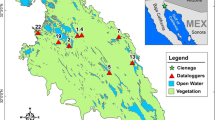Abstract
The distribution of temperature, salinity, visibility and dissolved oxygen was sampled from 1996 to 2002 at sites along the Seronera River. The minimum temperature decreased with distance upstream. The salinity increased up-river where occasionally hypersaline conditions prevailed. Dissolved oxygen was highly variable spatially and temporally, depending on both the level of eutrophication by animal dung and the presence of wetlands that help filter the excess nutrients. During the study period, fringing, freshwater wetlands have generally been degraded and in some cases destroyed, and this has been accompanied by significantly decreased oxygen levels, sometimes nearing anoxic conditions. Also during this period, saltwater wetlands have increased, and since wildlife impacted these wetlands little, dissolved oxygen levels remained high throughout. Visibility was highest in areas fringed by wetlands.
Similar content being viewed by others
References
CIMU. 2003. Aerial Census in the Serengeti Ecosystem, Wet Season, Preliminary Report. Tanzania Wildlife Research Institute, Arusha, Tanzania.
Dublin H.T. and Douglas-Hamilton I. 1987. Status and trend of elephants in the Serengeti-Mara ecosystem. African Journal of Ecology 25: 19–33.
Gereta E. and Wolanski E. 1998. Water quality-wildlife interaction in the Serengeti National Park, Tanzania. African Journal of Ecology 36(1): 1–14.
Gereta E., Wolanski E., Borner M. and Serneels S. 2002. Use of an ecohydrological model to predict the impact on the Serengeti ecosystem of deforestation, irrigation and the proposed Amala weir water diversion project in Kenya. Ecohydrology and Hydrobiology 2: 127–134.
Sinclair A.R. and Arcese P. 1995. Serengeti II: Dynamics, Management and Conservation of an Ecosystem. University of Chicago Press, Chicago.
TWCM. 1999. Serengeti Aerial Census. Tanzania Wildlife Conservation Monitoring, Arusha, Tanzania.
Verschuren J. 1993. Exploration du Parc National des Virungas. Les habitats et la grande faune: evolution et situation recente. Foundation pour Favoriser les Recherches Scientifiques en Afrique, Bruxelles.
Wolanski E. and Gereta E. 1999. Oxygen cycles in a hippo pool, Serengeti National Park, Tanzania. African Journal of Ecology. 37: 419–423.
Wolanski E. and Gereta E. 2001. Water quantity and quality as the factors driving the Serengeti ecosystem, Tanzania. Hydrobiologia 458: 169–180.
Wolanski E., Gereta E., Borner M. and Mduma S. 1999. Water, migration and the Serengeti ecosystem. American Scientist 87: 526–533.
Author information
Authors and Affiliations
Corresponding author
Rights and permissions
About this article
Cite this article
Gereta, E., Mwangomo, E. & Wolanski, E. The influence of wetlands in regulating water quality in the Seronera River, Serengeti National Park, Tanzania. Wetlands Ecol Manage 12, 301–307 (2004). https://doi.org/10.1007/s11273-005-0163-9
Received:
Accepted:
Issue Date:
DOI: https://doi.org/10.1007/s11273-005-0163-9




